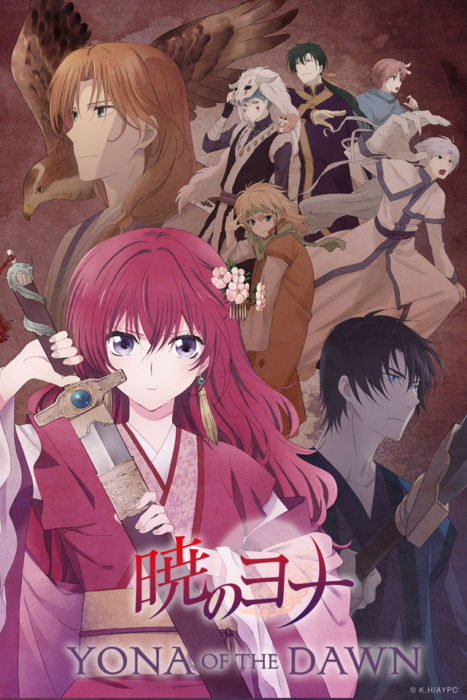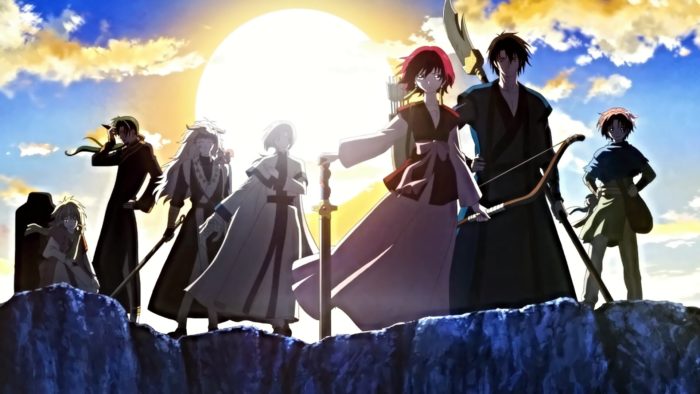‘Yona of the Dawn’ Forsakes Cozy Palace Life to Challenge Its Royal Heroine
I’ve watched through several well-made anime series at least once. But I’ve only seen a few great series more than once. Not long ago, I watched Yona of the Dawn for the third time, because this story holds up wonderfully with repeat watchings.
The dawn of Yona
On her sixteenth birth, Princess Yona’s pampered world is shattered when the man she’s in love with murders her father, King Iru.
Yona is forced to flee the castle. After several encounters, she meets an oracle who tells her what she must do. He refers to her country’s founding story about an ancient king and four dragon warriors. He tells Yona that she, as the descendant of that dragon king, must find the four modern warriors who still carry the blood of the dragon warriors. Together these men will aid her.
So, accompanied by her guard Hak and the jack-of-all-trades Yun, Yona sets out on a quest to find these four dragons.
 Our strong leading lady
Our strong leading lady
In the past several years we’ve heard plenty of controversy about the “strong female character.” In many ways, Yona of the Dawn gives a good example of such a heroine, though I think some people would still not be happy with Yona.
When we first meet Yona, she’s a bit of a royal brat. She’s a pampered princess whose main concerns are trying to get her unruly mop of red hair to cooperate, and getting Soo-Won, the love of her life, to notice her. 1
As the story develops, Yona grows, and her growth is hardly sudden or painless. She was raised by a peace-loving and almost pacifistic father, and had never held a weapon. In their travels, she asks Hak to teach her to shoot a bow, and her first few attempts are predictably bad. But here and there, we see glimpses of her rising early in the morning, walking a distance from camp, and shooting one arrow after another. Her arms are still weak and the arrow tip shakes. But she still shoots. So, when the time comes in the fight alongside pirates, and she takes up a bow against the leader of the enemies, her skill is not a surprise that comes out of nowhere, but a turn the story has taken time to set up.
This may be the greatest departure from the current stereotype of the “strong female character,” because in the popular version, this character must also be the strongest fighter—the gal who can kick anyone else in the story to the curb. Yona isn’t like that. She becomes a capable fighter. (In the manga, she later gets into a sword fight, and while she holds her own, she’s also hurt in that fight.) But she is not even close to the level of Hak or the dragons.
Yona does not only grow as a fighter. Born and raised in the royal palace, she knew almost nothing of the outside world. She thought the country loved her father and that people were happy and prosperous. After her exile, she’s shocked to see poor places with starving people, and to hear them speak harshly against the previous emperor, her father. Her struggles to make sense of these realities are painful to her.
This kind of character development is one of the biggest draws of this series.
Loyalty and betrayal
In flashbacks, we are shown the three main characters–Yona, Hak, and Soo-won–as children. We are given the picture of three kids who are very close to each other, and their closeness grows as they become young adults. It’s clear that Soo-won’s betrayal greatly hurt Yona.
What may not be so clear at first is how much Soo-won’s actions wounded his other friend, Hak. If any characteristic defines Hak, it’s loyalty. He was loyal to King Il, and his loyalty to Yona is based in part on his loyalty to her father. Hak was ready to stand loyally with Su-won, who was a nephew to the king and a possible successor to the throne.
After the night the king was killed, Hak and Soo-won do not meet again in the anime series. That does happen in the manga, in a scene the anime doesn’t reach, and it’s–well, for Hak, this scene is rather explosive. For once his mask slips, and we clearly see his rage and hurts.
Unexpected turns
This story’s unexpected turns easily keep viewers’ interest.
Much like The Promised Neverland, Yona of the Dawn‘s first episodes seems to show one kind of story: perhaps a teenage romance set in an eastern version of a fantasy world. Then, very quickly, the plot takes a hard turn and becomes a quest story.
Even then, the quests offer twists. The bright and enthusiastic village of White Dragon clashes with the Blue Dragon’s village, and even more with the Green Dragon’s home. And, in one final quest twist, there’s the Yellow Dragon. He shows up very late in the anime series, so there’s a lot of about him the series hasn’t reached.
The anime series’s current end brings a twist. Yona must decide what she and her companions will do.
By contrast, in other stories, the moment Yona got her overpowered dragon allies at her back, she’d use them to take down the usurper to the throne and have herself reinstalled as ruler. Sure, this would bring some sense of justice. But while avoiding spoilers, I can still note that getting revenge and regaining her position is not her immediate goal. Rather, the story turns again, from a quest to a road trip (with frequent fights and other adventures), as Yona focuses on smaller and more personal ways of helping the people of her country.
Sometimes we can try too hard to read Christian ideas into stories that are not themselves Christian. I want to avoid that here. But there is still something Christian-like in the theme of not seeking revenge, and in a wise ruler (Yona is still royalty, a princess) using her strengths to benefit her people and not for her own ends, even if those ends could be justified.
Conclusion
However, this anime series has one big problem: it’s stopped. The manga has now gone well past were the anime ended. So far I’ve come on no reliable word that the series will be continued.
For only this reason, maybe I would not rank Yona of the Dawn among my top-ranking series I’ve seen. Still, Yona of the Dawn mixes humorous moments with serious and emotional ones. Its twists and turns put new life into common story elements and character development. Given all these strengths, I recommend Yona of the Dawn as thought-provoking entertainment with insights and inspiration.
- Let’s get the story’s one big “ick!” factor out of the way: yes, Yona wanted to marry her cousin. Maybe it’s some kind of royalty thing. Anyway, that’s hardly a big possibility after the first episode. ↩






































I, too, have watched Yona more than once and am sorry to see it end. I keep hoping something will change.
Wonderful lessons on courage, loyalty, and compassion.
This looks like a decent series, from what I’ve read. I don’t mind strong (masculine) female roles, but modern western depictions equip them with obnoxious personality traits or meager character arcs. In anime, people of any sex doing extraordinary things is standard and assumed, so it fits well with the concept.
I also listen to the OP song on repeat
There are two of them: first, the epic rhythm and Yona’s main theme in the season’s first half; then, second, a more traditional EDM-style anime opening. Which one is your favorite?
The one that’s actually memorable. I had to look up the second one again aaaaaand it’s pretty blah J-pop.
This review comes at a perfect time for me, as I was just thinking “I really want to watch an anime”.
Also, marrying cousins was lot more common a couple centuries ago– I believe it happens a few times in Jane Austen. If my rudimentary understanding of genetics is at all accurate, this was significantly less likely to produce disabled children because the total number of mutations accumulated in the human genome was a lot less.
First-cousin marriage was more common, but I imagine it was more about inheritance and property than anything else.
But it’s the cumulative effect of near-relational marriages that’s the gronk-producing thing. One first-cousin marriage probably isn’t going to muddy the genetic pool that hard, but consistent ones across the generations is what gave us the Hapsburgs.
You’d actually want MORE diversity in your genetic pool (more mutations and variations) than fewer for genetic stability.
Variations are arguably not always due to mutations. Though that depends on who you ask.
But “clearly harmful mutations based on a single or a few defective gene(s)” which is what are most things most people call “mutations” (like flat feet, color blindness, type one diabetes, or hemophilia), clearly you want less of.
Greater genetic diversity in general prevents mutations that people are already carrying from being expressed in the “phenotype,” i.e. what people are like. So one copy of bad genes can be made up for by a copy of good genes but inbred people concentrate the bad genes.
People without as many defective genes could inbreed with less harm that people carrying a lot of defective mutations. Not that I’m recommending inbreeding–just pointing out a fact.